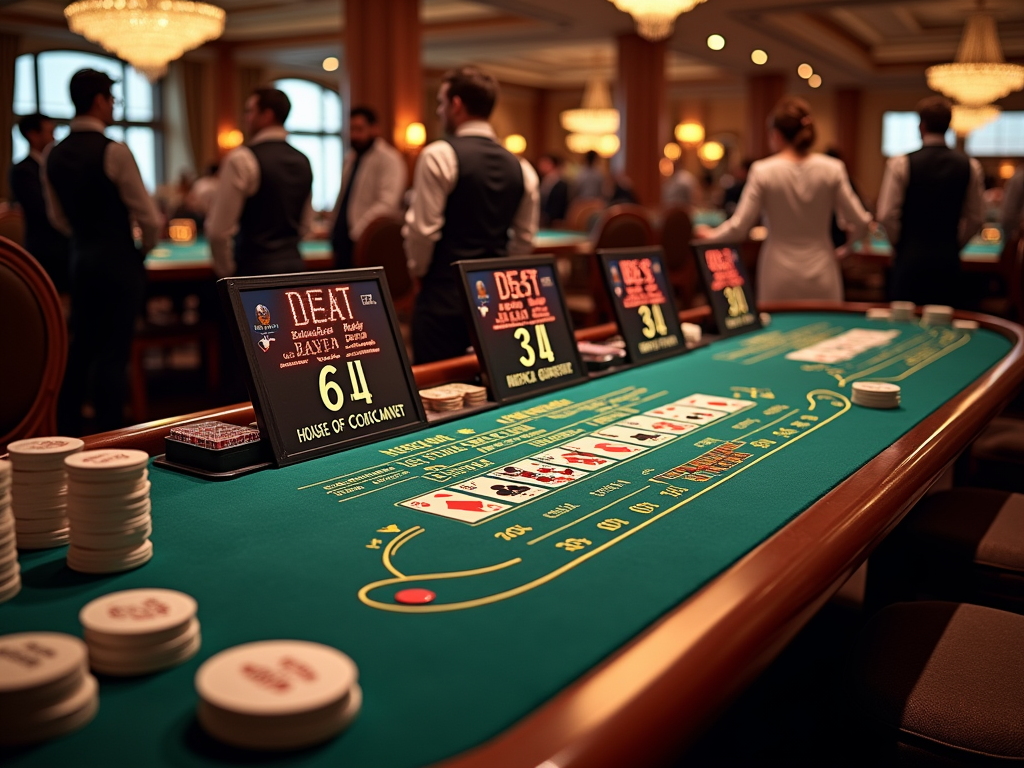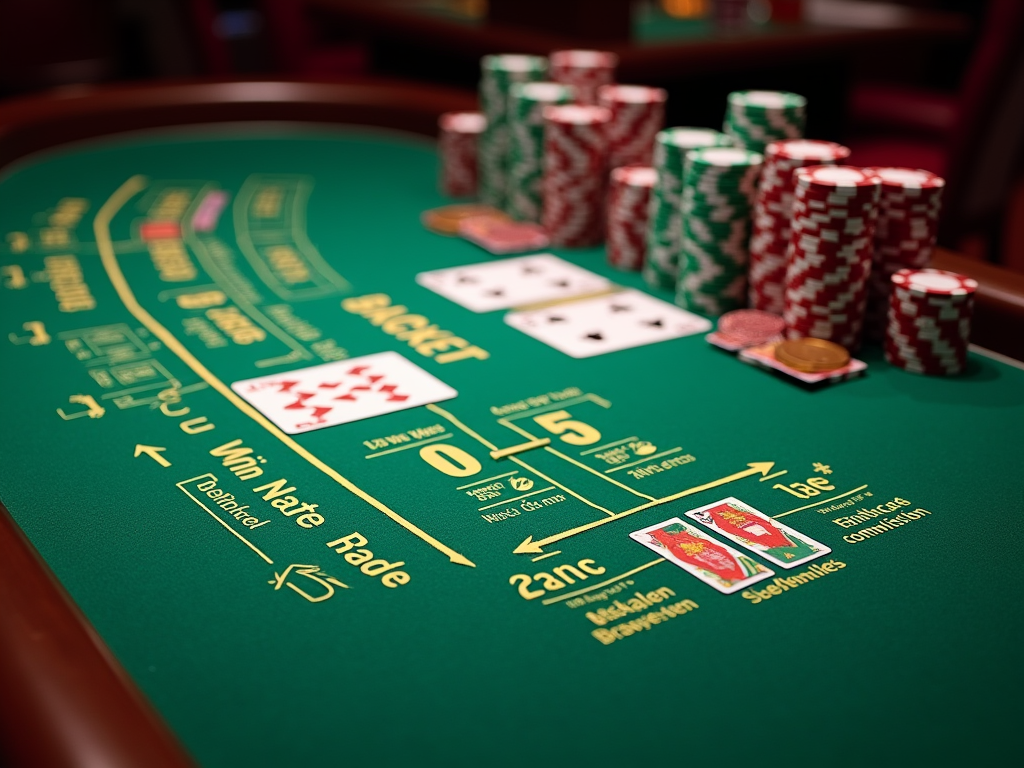The Statistical Edge of the Banker Hand in Baccarat
The Banker hand in baccarat offers a notable statistical edge, with a 45.86% win rate compared to the Player hand’s 44.62%. This makes the Banker bet the optimal wager, even after accounting for the 5% commission charged on winning Banker bets. This advantage primarily stems from the specific third-card drawing rules, which allow the Banker to act with more information than the Player.
Key Takeaways
- Banker bets carry a lower house edge of 1.06% compared to 1.24% on Player bets, making it a better long-term strategy.
- Excluding ties, the Banker wins 50.68% of resolved hands, while the Player wins 49.32%.
- Tie bets occur in 9.52% of hands and come with a steep house edge of 14.36%.
- The Banker’s edge is rooted in greater flexibility and better information due to third-card rules.
- Multi-deck variations, such as 6 or 8 decks, have minimal impact on the fundamental probabilities and overall optimal strategy.
Understanding the Advantage
The grip of mathematics steers my betting decisions in baccarat. The Banker bet consistently draws my attention due to its concrete probability advantages. This edge is primarily driven by the additional information the Banker receives from the Player’s third-card action before proceeding.
Strategic players acknowledge these embedded statistical facts and integrate them into their long-term approach. The seemingly unfair 5% commission exists precisely because casinos must balance out the inherent advantage the Banker holds, derived from the systematic structure of the game.
The House Edge Battle: Why Banker Bets Have a Statistical Advantage
I’ve found that the Banker position in Baccarat holds several key mathematical advantages that make it the smartest betting choice. Let’s break down the cold, hard numbers to understand why.
Breaking Down the Win Percentages
The raw statistics tell a compelling story – the Banker hand wins 45.86% of all deals, while the Player hand claims victory in 44.62% of cases. When ties are removed from the equation and we look at only resolved hands, the Banker’s dominance becomes even clearer, winning 50.68% of these outcomes.
Here’s what makes these numbers particularly important for your betting strategy:
- The house edge on Banker bets sits at just 1.06%, even after accounting for the 5% commission on winning Banker bets
- Player bets carry a higher house edge of 1.24%
- The difference of 0.18% in house edge might seem small, but it adds up significantly over multiple hands
The Banker’s statistical advantage stems from the third-card drawing rules. These rules give the Banker position more flexibility and information when making drawing decisions. The Banker gets to act last and can base its drawing decision on whether the Player drew a card and what that card was.
The 5% commission on winning Banker bets might seem like a deterrent at first glance. However, I can confirm that even with this fee, the Banker bet remains the mathematically superior choice. The lower house edge more than makes up for the commission over the long run.
The third-card rules create this advantage through a careful balance of drawing opportunities. When the Player draws a third card, the Banker has specific rules about when to draw based on the Player’s card value. This strategic advantage in the drawing rules contributes directly to the Banker’s higher win percentage.
Remember, while short-term results can vary wildly, these probabilities represent what happens over thousands of hands. The mathematical edge of the Banker bet becomes more apparent the longer you play, making it the statistically optimal choice for consistent baccarat betting.
Breaking Down the Tie Bet’s High-Risk, High-Reward Nature
Understanding Tie Bet Frequency and Payouts
Let’s cut straight to the facts – tie bets in baccarat happen in just 9.52% of all hands dealt. While that might sound like a decent frequency, it means you’ll lose this bet about 90% of the time. The standard payout for catching a tie is 8:1, with some casinos sweetening the deal by offering 9:1. At first glance, these payouts can look mighty attractive to players searching for that big win.
The Real Cost of Chasing Ties
Here’s where the numbers tell the real story. The house edge on tie bets sits at a steep 14.36%. I can’t stress enough how significant this is when you compare it to the other main bets in baccarat. The banker bet carries just a 1.06% house edge, while the player bet comes in at 1.24%.
Consider these key factors that make tie bets so risky:
- You’ll lose roughly 9 out of 10 bets you place
- The high 14.36% house edge means you’re giving up nearly 15 cents on every dollar wagered
- Even with higher 9:1 payouts, the mathematical disadvantage remains substantial
- Your bankroll faces much faster depletion compared to standard banker or player bets
The statistical evidence clearly shows that tie bets consistently rank as the poorest choice for players looking to maintain their bankroll. While the allure of a big payout might be tempting, the math simply doesn’t support making this bet a regular part of your baccarat strategy.

Master the Basics: Card Values and Hand Totals
How Cards Are Counted in Baccarat
I’ve found that baccarat’s scoring system makes it one of the easiest casino games to learn. Let me break down the card values for you — they’re straightforward and logical.
Here’s how each card is valued in baccarat:
- Aces = 1 point
- 2 through 9 = Face value (2 points for a 2, 3 points for a 3, etc.)
- 10s and face cards (Jack, Queen, King) = 0 points
The magic number in baccarat is 9. Each hand aims to get as close to this number as possible. If your cards total more than 9, there’s a simple fix — just drop the first digit. For instance, if you draw a 7 and a 9, that equals 16. Drop the 1, and your hand value becomes 6.
Quick Examples of Hand Totals
- 4 + 5 = 9 (Perfect hand)
- 8 + 7 = 15, becomes 5
- King + 3 = 3 (Remember, King = 0)
- 9 + 6 = 15, becomes 5
Before placing any bets, I recommend getting comfortable with these card values and the three main betting options: Player, Banker, and Tie. The goal is simple — pick which hand you think will end up closest to 9. That’s all there is to it!
Understanding Third-Card Rules
Player’s Drawing Rules
When playing baccarat, I’ve found that knowing the third-card rules can make a huge difference in understanding why certain outcomes happen. The Player’s hand follows straightforward rules — draw a third card on totals of 0–5 and stand pat on totals of 6–7. This simple system takes away any decision-making on the player’s part.
Banker’s Conditional Drawing Rules
The Banker’s drawing rules are more detailed and change based on two key factors: the Banker’s current total and what third card the Player received. Here’s what you need to know about these conditional rules:
- Banker draws on 0–2 regardless of Player’s third card
- With a total of 3, Banker draws unless Player’s third card is 8
- With a total of 4, Banker draws on Player’s third card of 2–7
- With a total of 5, Banker draws only on Player’s third card of 4–7
- With a total of 6, Banker draws only on Player’s third card of 6–7
- Banker stands on 7
These specific conditions create an inherent mathematical edge for the Banker bet. I’ve noticed many players skip learning these rules since the dealer handles all the decisions. But understanding them helps explain why the Banker bet wins slightly more often over time. The rules give the Banker position more flexibility to improve its hand based on complete information about the Player’s cards. This strategic advantage, while small, adds up over many hands to create the Banker’s statistical edge.
How Different Deck Counts Affect Your Odds
The Impact of Deck Size on House Edge
The number of decks used in baccarat has a subtle yet noticeable effect on your odds of winning. In modern casinos, you’ll typically find either 6 or 8-deck games, which have become the standard. I’ve noticed that single-deck games are quite scarce, but they do offer a slight advantage with the Banker bet carrying a 1.01% house edge — marginally better than multi-deck versions.
Multi-Deck Strategy Considerations
The shift between 6 and 8-deck games creates such tiny variations in the odds that it shouldn’t affect your betting choices. Here’s what I’ve found matters most about deck counts in baccarat:
- The Banker bet remains your strongest option across all deck variations
- House edge differences between 6 and 8 decks are less than 0.01%
- Card counting becomes less effective as deck numbers increase
- The commission on Banker bets stays fixed at 5% regardless of deck count
The core mechanics of baccarat maintain the Banker bet’s statistical advantage whether you’re playing with a single deck or eight. This consistent edge exists because of the fundamental rules governing drawing cards, not the number of decks in play. I’ve found that players can stick to their preferred betting patterns without worrying about adjusting their strategy based on deck count.
The mathematical stability of baccarat means you can focus on other aspects of your game, like money management and maintaining discipline with your betting limits. Since the variations in odds are so minor between different deck counts, I recommend choosing your table based on comfort, minimum bets, and table atmosphere rather than the number of decks in play.

The Math Behind Player vs Banker Probability
Breaking Down the Win Percentages
I’ve found that understanding the mathematical probabilities in baccarat helps cut through the noise of betting systems and superstitions. Let’s look at the hard numbers that shape optimal betting strategy.
The Player hand wins 44.62% of dealt hands. When I remove ties from the equation, that percentage increases to 49.32% of decisively completed hands. While this might seem close to a coin flip, the small percentage gap makes a significant difference in long-term results.
Here’s what you need to know about the core probabilities:
- Player hand wins: 44.62% of all hands
- Banker hand wins: 45.86% of all hands
- Ties occur: 9.52% of all hands
Despite the Banker’s 5% commission on winning bets, this betting option maintains a lower house edge at 1.06% compared to the Player bet’s 1.24%. The commission might feel like a deterrent, but the math confirms it’s still the superior choice for sustained play.
When analyzing expected value over thousands of hands, the Banker bet’s statistical advantage becomes clear. The 0.18% difference in house edge between Banker and Player bets means I’ll lose less money over time by consistently backing the Banker position, even after accounting for the commission.
These probability differences might appear minor at first glance, but they compound significantly across multiple hands. That’s why experienced players often stick to the Banker bet – it’s not about hunches or patterns, but rather following the mathematical proof of better long-term outcomes.
Sources:
Wizard of Odds – Baccarat section
888 Casino Blog – Baccarat Odds and Probability Explained: How To Consistently Beat the House Edge
Casino.org – Baccarat Odds Guide 2024 – Understanding Baccarat Payouts & Probability





